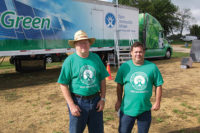
As of this spring, three of the stores using CO2 have come on-line with a fourth under construction. The refrigeration contracting company Frigrite is performing the installation.
Paul Sheahen, the company's national contracts and engineering manager, said, "We have spent countless hours developing a range of cabinets specifically designed to operate on CO2.
"The plant design is based on a cascade system using R-404A and R-744 (CO2). We have set up a R-404A parallel rack on the high side of the cascade evaporating at -15°C. The low side is set up to condense CO2 at -10°C (370 psig).
"The liquid receiver contains the liquid CO2 at –10°C. There is a vapor line from the top of the receiver back into the condenser, so if there is any great pressure rise in the receiver the condenser has a chance to recondense the vapor before any pressure relief happens. We have had the R-404A plant down for service reasons for a couple of hours without a pressure issue, with the CO2 in the vessel that is well insulated and stable.
"We have installed a small cooling coil around the outside of the receiver that is operated on emergency power backup if the store has a power failure or plant failure. In Melbourne, one day last January (a summer month in Australia), we had the power supply off for a period of four hours, but the system was sound and functioned as required.
"I don't mind saying I was very relieved it worked."
Sheahen went on to say that "the low temp system is operated as a typical pressure drop system using Danfoss AKV electronic expansion valves with CO2 entering the case at -10°C, expanding and leaving at -30°C as a saturated vapor. The pressure at this point is around 232 psig, so it not an issue. Defrost is conventional electric using a pumpdown process that eliminates any CO2 being captured in the evaporators during the defrost period."
"The liquid is much colder than needed. However the evaporators in the cases and rooms are much smaller than those needed for R-404A or R-22. We have overcome pressure-rating problems with piping by running all small-bore tubing from the plant to the store.
"The efficiency of CO2 is so much higher than R-404A, that all the components are substantially smaller. An example would be 3- by 12-foot dairy cases feeding refrigerant off a loop main using R-22 that would need 1-3/8-inch suction line and 3/4-inch liquid line. CO2 would require 1/2 and 1/2.
"All the components used on the CO2 side had to be rated at a pressure of 42 bar (620 psig).
"We had a few problems getting started. However we were able to obtain replacement parts."
Sheahen said the original intent of the project was to reduce the amount of HFC refrigerant charge in the stores. The resulting power savings being realized "would be classed as a bonus."
SPACE OKAY
Space was not an issue as the CO2 plant required less than a conventional system. For example, the outdoor condenser deck requirement was reduced.Sheahen said CO2 would continue to become cheaper to install. "Solid progress has been gained from our development program in reducing the capital cost of a CO2 installation from 20 percent to now less than 10 percent. We are anticipating that this cost will be reduced even further with future developments."
He said he hoped eventually CO2 systems will be installed for the same cost as conventional systems.
Publication date: 09/04/2006





